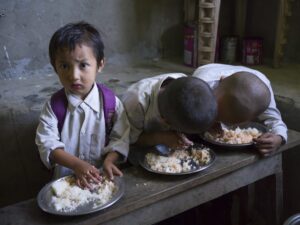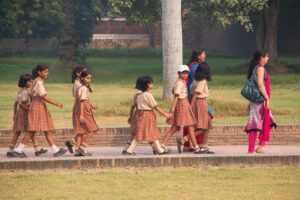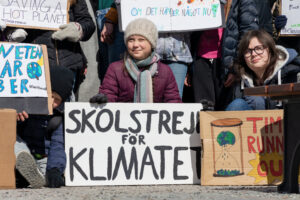Child health and wellbeing: “The most powerful investments a society can make”

What kind of country does one wish theirs to be? There are many possible answers to this question. Perhaps one of the most compelling and morally imperative answers would be that it is a country that provides for its children – in both the immediate and longer terms, guaranteeing adolescent and child health and wellbeing and a future conducive to their prosperity, wellbeing, and success.
That kind of country is defined by a landmark report published in The Lancet by a Commission convened by The Lancet, UNICEF, and the World Health Organization (WHO). “Countries that support future generations put a high priority on ensuring all children’s needs are met, by delivering entitlements, such as paid parental leave, free primary healthcare at the point of delivery, access to healthy – and sufficient amounts of – food, state-funded or subsidised education, and other social protection measures.
“These countries make sure children grow up in safe and healthy environments, with clean water and air and safe spaces to play. They respect the equal rights of girls, boys, and those with non-conforming gender identities.
“Policy makers in these countries are concerned with the effect of all policies on all children, but especially those in poorer families and marginalised populations, starting by ensuring birth registration so that the government can provide for children across the life course, and help them to become engaged and productive adult citizens.”
With this in mind, the question remains: is India that country?
Are we that world?

“An uncertain future”
A popular adage asserts that “we do not inherit the earth from our ancestors; we borrow it from our children.” The world today, however, leaves children facing “an uncertain future” according to the Commission. Professor Anthony Costello, a co-author of the report, told Health Issues India that at present, “the health and future of every child and adolescent worldwide is under immediate threat from ecological degradation, climate change and exploitative marketing practices that push heavily processed fast food, sugary drinks, alcohol, gambling and tobacco at children.”
Sustainable Development Goals (SDGs), the report argues, must foreground the health and wellbeing of children and adolescents. However, almost five years since they were adopted, “few countries have recorded much progress towards achieving them.”
In many respects, India lags on the SDGs. While the country has made some improvements, it continues to face significant socioeconomic inequities. It frequently reels from the effects of a changing climate and chokes on toxic air as a result of pollution. It is home to a dual burden of malnutrition that sees swathes of its young people either severely undernourished or dangerously overweight. It grapples with pervasive sex discrimination and gender bias that threatens the health and lives of the country’s girls and women. It bears a high burden of communicable and noncommunicable diseases and health issues linked to maternal, neonatal, and perinatal conditions. Readily accessible and affordable healthcare is not the reality for many of the country’s citizens.

In all, the health and wellbeing of children and adolescents are not fully supported by any country. As to how India fares, on a flourishing index, aiming “to measure the foundational conditions for children aged 0-18 years to survive and thrive today” of 180 countries, India ranks 131st. In rankings of countries by sustainability, India ranks 77th.
The country faces numerous issues that adversely affect its young people. Malnutrition, for example, is widespread in the form of both undernourishment and obesity. 68 percent of deaths of children under five were accounted for by malnutrition in 2017, translating to seven lakh lives lost. India bears a high burden of conditions such as stunting and wasting, the prevalence of which stood at 32.7 percent and 15.7 percent respectively in 2017.
Meanwhile, obesity is on the rise among Indian youth even as it continues to house a staggering number of the world’s hungry children – a dual burden of malnutrition which presents a major challenge to policymakers and other stakeholders given the manifold interventions needed. India is expected to be a major driver of the global burden of childhood obesity. By 2030, the country is expected to be home to 27 million obese children.
How commercial marketing harms child health and wellbeing
Numerous factors are linked to India’s growing burden of overweight and obesity, including the availability of junk food which the report highlights. The marketing of junk food is highlighted in the report, with Professor Costello telling Health Issues India that “we need states to tighten national regulation of harmful commercial marketing, especially internet and mobile targeting of children.”
Such marketing extends from junk food to other harmful products such as tobacco and alcohol. Surveys suggest that the majority of Indians begin to consume alcohol before reaching the legal drinking age. Meanwhile, 429,500 boys aged ten to fourteen years use tobacco daily in India, as well as 195,500 girls in the same age bracket. Past exposés have revealed the use of illicit tactics by tobacco firms specifically targeting young people. However, it is worth noting that the Government has taken a hard line against tobacco companies in recent years and, in a bid to improve the health of young people, imposed a ban on e-cigarettes last year (albeit controversially).
To support states efforts in clamping down on harmful commercial marketing targeting young people, Costello says “a new Optional Protocol to the UN Convention on the Rights of the Child” is needed. The paper elaborates that “although we recognise the role business plays in wealth and job creation, the commercial sector’s profit motive poses many threats to child health and wellbeing…children around the world are enormously exposed to advertising from business whose marketing techniques exploit their developmental vulnerability and whose products can harm their health and wellbeing.”
The report dismisses the notion of self-regulation by the sector itself, whilst arguing that “the existing global frameworks are not sufficient.” As such, it recommends the Optional Protocol, an additional component to the UN Convention on the Rights of the Child, “which would require national governments to prohibit or regulate the types of products that should not be marketed to or for children” and “regulate specific methods of marketing to children (via television shows, games, and social media used by children and youth, and sponsorship of youth activities).”
Climate change: A threat to young people’s future
One threat to child health and wellbeing emphasised in the report is climate change. The effects of climate change on child health and wellbeing are immensely damaging. “The ecological damage unleashed today endangers the future of children’s lives on our planet, their only home,” the Lancet Commission report said.
“In stopping CO2 emissions with the utmost urgency we must demand political leadership at the very top to protect our children, to stop subsidies of fossil fuels (which are now more expensive than renewables), press for a shift from income taxes to carbon taxes, and expedite a massive change in our food system and in reforesting wherever we can,” Costello tells me. “Remember all countries signed up to the Paris Accords to limit global warming to 1.5 degrees. Yet we shall exceed that aim through our current level of emissions within ten years. We don’t want to bequeath our children an unsafe world, with increasing heatwaves, proliferation of diseases like malaria and dengue, water shortages, population migration and malnutrition. India faces all of these challenges in the near future.”

Put simply, the “dramatic improvements in survival, education and nutrition for children worldwide” made in the last half-century are under threat due to climate change. This is intricately interconnected with “economic structures and commercial activity”, with “wealthy countries [that] generally have better child health and development outcomes” also accounting for “historic and current greenhouse gas emissions [threatening] the lives of all children…as a result, our understanding of progress on child health and wellbeing must give priority to measures of ecological sustainability and equity to ensure we protect all children, including the most vulnerable.”
India’s performance on environmental indicators is mixed. Whilst it has been pledged in the past to “go beyond” its commitments as a signatory to the Paris Agreement and seeks to expand its output of renewable energy, it also continues to grapple with staggering amounts of air and water pollution and has an energy infrastructure that is retrograde in many respects. The country has actually been named the worst in the world for environmental health in the past – and with the Lancet report emphasising the contribution of environmental degradation and climate change on the health and wellbeing of the country’s youth, there is a mighty onus on India to act now and act decisively.
“The Indian government,” Costello says, “should recognise that every effort to tackle climate change will be good for the health of children and all families: clean air, clean water, better play areas, safer roads, better nutrition, and population stability.”
A roadmap towards child health and wellbeing
With the vision of what “countries that support future generations” look like outlined by the report, it is clear that India is not that country in many respects. There is much work to be done and it is feasible. The report emphasises the investments in child health and wellbeing are cost-effective and that the world stands to gain from maximising the potential of its young people, of all gender identities and including those affected by developmental disabilities – the potential of whom the report states “too often…is neglected, restricting their contributions to society.”
The report states that “an analysis of the SDGs suggests a financing gap of US$195 per person. To ensure stronger economic and human development, each government must assess how to mobilise funding using instruments that help the poorest proportion of the population to meet this gap for children and frame these as the most powerful investments a society can make.” Professor Costello emphasises to Health Issues India that “we need much greater investment in children to deal with the financing gap of $195 per person per year if we are to achieve the Sustainable Development Goal targets by 2030.”
In addition, data collection is essential. “We only found a very small amount of country data for the indicators used to track child health and wellbeing, which all countries agreed to collect,” the report states. “SDG monitoring needs a strong boost in investment to bridge the large data gaps in key indicators…to ensure our children grow and flourish, we require timely and accurate population data on health, nutrition, educational access and performance, housing, and environmental security, among other entitlements.”

Guaranteeing child health and wellbeing a moral imperative
No one sector can go it alone. Government commitment is needed: Professor Costello highlighted that “we need Prime Ministers and cabinets to think across ALL Ministries about the impacts on children’s health development and future: education, transport, environment, urban planning, finance, trade and so on.” The report emphasises that “since threats to child health and wellbeing originate in all sectors, a deliberately multisectoral approach is needed to ensure children and adolescents survive and thrive form the ages of 0-18 years, today and in the future. Citizen participation is a must, as is soliciting the inputs of children and adolescents themselves.
“We need countries to listen to children’s voices and involve them in national, local and community planning,” Costello tells me. Indeed, as the report notes, “children and young people are full of energy, ideas and hope for the future. They are also angry about the state of the world.” As they raise their voices, it is the moral imperative of governments everywhere to listen and to act accordingly.
What the world and future generations need is “a new global movement for child and adolescent health.” One cannot afford to look only into the immediate future; they must address the long-term ramifications of what failing to act on the health and development challenges of our time will mean for our planet and its people. The building of “a new global movement” is cost-effective, morally imperative and, as the report underlines, “an urgent necessity.”
“A future for the world’s children: A WHO-UNICEF-Lancet Commission” can be accessed here. The Commission’s homepage can be accessed here.


Investing in child health & wellbeing will help our children realize their full potential in the long-term. One key component of this strategy is implementation of a Comprehensive School Program in every school in India. We believe that Health Education should be mandatory in every school and at every grade level in India. This is the mission of our NGO “Tarang Health Alliance”. We have developed a comprehensive curriculum that covers Physical, Social and Mental Health. We plan to conduct our pilot in a few schools in Delhi this year. We will then scale-up accordingly.